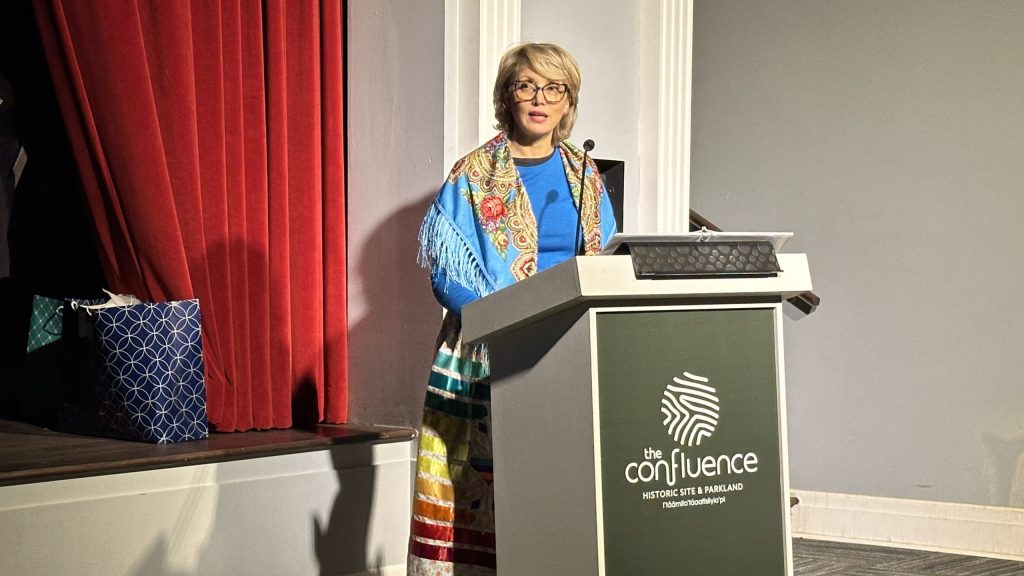Calls grow louder for deep-sea port in Iqaluit as it becomes Arctic boom town
Posted Jul 14, 2014 11:53 am.
This article is more than 5 years old.
IQALUIT, Nunavut – Iqaluit, a territorial capital in a G7 nation, is an Arctic boomtown perched on the northern shores of Frobisher Bay — but the Nunavut town’s waterfront has scarcely changed since English explorer Martin Frobisher sailed into the inlet in 1576.
The growing community, clamouring for supplies that include building materials, construction equipment and all-terrain vehicles, boasts some of the world’s highest tides.
In the summer months, mammoth barges are forced to work around the 12-metre tides and race to unload their cargo onto the town’s craggy public beach, still studded with ice in mid-July. Sometimes they can’t unload at all because of high winds and excessive ice.
It’s a process that takes weeks longer than it would if even the most basic marine infrastructure existed in Iqaluit — such as a dock or working causeway. The city of Iqaluit has lobbied for a $65-million deep-sea port in recent years, but has gone mute on its current efforts, with officials declining to respond to requests for interviews.
In Greenland, the coastal town of Nuuk boasts a pristine deep-sea port and, unlike much of Iqaluit, paved roads. Denmark invests heavily in Greenland.
In Nunavik, Quebec’s Arctic region, there’s also been steady investment in marine infrastructure by the provincial and federal governments, easing the business of dropping off precious cargo to communities in need.
Not so for Iqaluit, considered Canada’s gateway to the high Arctic, a region where oil and gas exploration is on the brink of wide-scale development thanks to climate change. This despite the fact Ottawa seems intent on showcasing the town, even hosting a G7 finance ministers’ summit here in 2010.
Residents, local business owners and shipping companies alike are pleading with the municipal, territorial and federal governments to find the millions to do something about Iqaluit’s waterfront as the town of almost 7,000 buzzes with commerce, construction and a growing population.
“It would have a domino effect on everything,” said Allan Mullin, a New Brunswick-born contractor and Inuit art dealer who’s lost money and building supplies when ships have been unable to unload on the beach.
Suzanne Paquin, president of Nunavut Eastern Arctic Shipping, agrees that a serious investment in marine infrastructure in Iqaluit — at the very least, rebuilding a Second World War-era causeway that is beyond the low-tide mark — would help solve a host of other problems confronting the community.
“Economic development in the North can only happen through proper marine infrastructure,” said Paquin said in an interview from Montreal as her company prepared for an Iqaluit sealift next week.
“The lack of infrastructure is like a hidden tax on all the development, because everything costs so much more due to the lack of infrastructure; housing, hospital projects, basic building materials.”
Along with a lack of social housing, Iqaluit is grappling with crowded living conditions thought to be contributing to rising tuberculosis rates, sky-high food prices that have prompted the Inuit to organize protests, and high suicide rates.
A 2011 study by the National Aboriginal Health Organization said a key factor contributing to the high cost of housing in the North is the expense involved in shipping building materials, a limited shipping season and a lack of accessible roads to communities.
Iqaluit’s waterfront in particular, Paquin complained, hasn’t changed since Frobisher’s era.
“It really hasn’t at all. But our operations have changed, our vessels have gotten a lot bigger, our capacity for lifting cargo has increased significantly. There is more and more activity in the North, and yet there is absolutely nothing that has changed in Nunavut.”
What’s more, she said, the town’s brigade of bike-riding Inuit children zip to the beach to take in the sealift up close, running and hopping among the containers on the muddy, sometimes icy shores as cargo is unloaded from the barges via tugboats, then tractors with forklifts.
“There’s no fencing, no barriers; there’s nothing, no supervision. It’s not our land, it’s public land, so there are kids jumping from one container to the other, biking through. It’s crazy. It’s an accident waiting to happen.”
Paquin held out hope that the federal government’s major infrastructure project, the Building Canada Fund, will provide some assistance — but Nunavut hasn’t applied for marine infrastructure funding under the program, and is instead focusing on upgrading the town’s airport, a spokeswoman for Premier Peter Taptuna said.
Iqaluit’s waterfront, Yasmina Pepa added, is under municipal jurisdiction.
Paquin suggested the feds need to take ownership. In 2009, after all, Prime Minister Stephen Harper announced the construction of a small craft harbour in Pangnirtung, further north on Baffin Island, which opened last year.
“There is federal money for infrastructure, but money in the North can be used for a lot of things — community centres, hockey arenas. All of that falls under infrastructure because the needs of the North are huge,” said Paquin.
“But marine infrastructure needs to be the priority, because it’s critical to get the goods north to build all that other infrastructure.”
The Building Canada Fund officially launched on April 1 of this year, with Edmonton receiving the first announcement on May 26 to fund a light-rail extension. There’s been no word of any money coming to Iqaluit.
“It’s up to local governments to apply for funding,” Vincent Rabault, spokesman for federal Infrastructure Minister Denis Lebel, said in an email.
Joe Hess, who runs a local shop selling Inuit “country foods” such as Arctic char, whale meat and caribou, said he’s puzzled by all the buck-passing.
“I don’t know if they can’t get the money or they don’t want to get the money,” he said of government officials.
“I don’t know what the problem is, but something definitely has to happen, because there’s no way they can continue without it.”
Follow Lee-Anne Goodman on Twitter at @leeanne25










